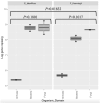The phyllosphere of Nigerian medicinal plants, Euphorbia lateriflora and Ficus thonningii is inhabited by a specific microbiota
- PMID: 39354019
- PMCID: PMC11448504
- DOI: 10.1038/s41598-024-68001-w
The phyllosphere of Nigerian medicinal plants, Euphorbia lateriflora and Ficus thonningii is inhabited by a specific microbiota
Abstract
The microbiota of medicinal plants is known to be highly specific and can contribute to medicinal activity. However, the majority of plant species have not yet been studied. Here, we investigated the phyllosphere composition of two common Nigerian medicinal plants, Euphorbia lateriflora and Ficus thonningii, by a polyphasic approach combining analyses of metagenomic DNA and isolates. Microbial abundance estimated via qPCR using specific marker gene primers showed that all leaf samples were densely colonized, with up to 108 per gram of leaf, with higher bacterial and fungal abundance than Archaea. While no statistically significant differences between both plant species were found for abundance, amplicon sequencing of 16S rRNA and ITS genes revealed distinct microbiota compositions. Only seven of the 27 genera isolated were represented on both plants, e.g. dominant Sphingomonas spp., and numerous members of Xanthomonadaceae and Enterobacteriaceae. The most dominant fungal families on both plants were Cladosporiaceae, Mycosphaerellaceae and Trichosphaeriaceae. In addition, 225 plant-specific isolates were identified, with Pseudomonadota and Enterobacteriaceae being dominant. Interestingly, 29 isolates are likely species previously unknown, and 14 of these belong to Burkholderiales. However, a high proportion, 56% and 40% of the isolates from E. lateriflora and F. thonningii, respectively, were characterized as various Escherichia coli. The growth of most of the bacterial isolates was not influenced by extractable secondary metabolites of plants. Our results suggest that a specific and diverse microbial community inhabits the leaves of both E. lateriflora and F. thonningii, including potentially new species and producers of antimicrobials.
Keywords: Euphorbia lateriflora; Ficus thonningii; Antimicrobials; Medicinal plants; Phyllosphere.
© 2024. The Author(s).
Conflict of interest statement
The authors declare no competing interests.
Figures





Similar articles
-
The effects of small geographical resolution and age on the phyllosphere microbial diversity of Castanopsis eyrei in subtropical forest.Microbiol Spectr. 2025 Mar 4;13(3):e0209124. doi: 10.1128/spectrum.02091-24. Epub 2025 Feb 12. Microbiol Spectr. 2025. PMID: 39936891 Free PMC article.
-
Effects of saffron-grape intercropping on saffron flower number and rhizosphere microbial community.BMC Microbiol. 2024 Dec 30;24(1):551. doi: 10.1186/s12866-024-03716-4. BMC Microbiol. 2024. PMID: 39736513 Free PMC article.
-
Microbiome Analysis of Area in Proximity to White Spot Lesions Reveals More Harmful Plant Pathogens in Maize.Biomolecules. 2025 Feb 9;15(2):252. doi: 10.3390/biom15020252. Biomolecules. 2025. PMID: 40001555 Free PMC article.
-
Sertindole for schizophrenia.Cochrane Database Syst Rev. 2005 Jul 20;2005(3):CD001715. doi: 10.1002/14651858.CD001715.pub2. Cochrane Database Syst Rev. 2005. PMID: 16034864 Free PMC article.
-
Systemic pharmacological treatments for chronic plaque psoriasis: a network meta-analysis.Cochrane Database Syst Rev. 2021 Apr 19;4(4):CD011535. doi: 10.1002/14651858.CD011535.pub4. Cochrane Database Syst Rev. 2021. Update in: Cochrane Database Syst Rev. 2022 May 23;5:CD011535. doi: 10.1002/14651858.CD011535.pub5. PMID: 33871055 Free PMC article. Updated.
References
-
- Vorholt, J. A. Microbial life in the phyllosphere. Nat. Publ. Gr.10, 828–840 (2012). - PubMed
-
- Knief, C., Ramette, A., Frances, L., Alonso-blanco, C. & Vorholt, J. A. Site and plant species are important determinants of the Methylobacterium community composition in the plant phyllosphere. ISME J.4, 719–728 (2010). - PubMed
MeSH terms
Substances
LinkOut - more resources
Full Text Sources
Medical
Miscellaneous

